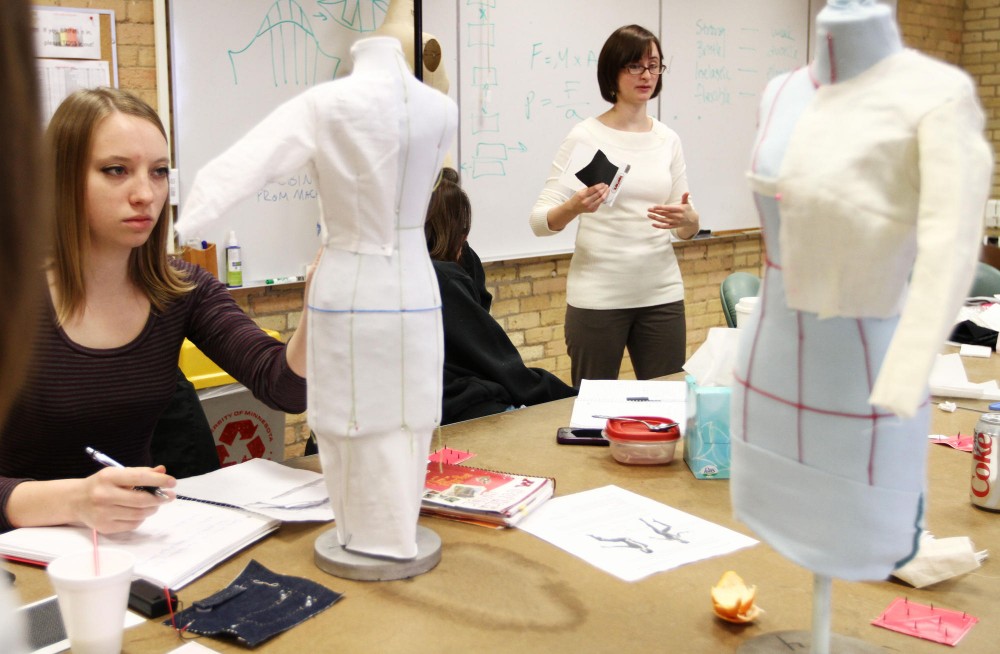When Mai Yang registered for Apparel Design Studio IV, she didnâÄôt expect to learn about electrical engineering and wiring circuits.
The apparel design junior also didnâÄôt plan on crafting a space suit to present before NASA in Houston this spring. Yang and 11 other students are working on prototypes for a functional spacesuit in Lucy DunneâÄôs 3000-level design class.
The project got started last year when Cory Simon, a human systems engineer with NASA, contacted Dunne. His branch is working with the class because he was interested in DunneâÄôs research on e-textiles âÄîwearable technology.
âÄú[NASA] is interested in putting the controls for the various shuttle systems and devices that are in the crewâÄôs environment on to the body, instead of having them go interact with a computer,âÄù Dunne said.
NASAâÄôs Johnson Space Center gave the 12 students in DunneâÄôs all-female class a set of problems to tackle, and they go beyond e-textile interfaces. Students have to think about comfortable fitting boots, liquid cooling garments and other challenges as well, Simon said.
âÄúThroughout the project weâÄôll give some perspective about whatâÄôs unique about space and what theyâÄôll need to take into consideration,âÄù he said.
Throughout the semester, Yang is designing an internal alarm system for the suit that can warn an astronaut of problems.
âÄúFor example, if he is working on a project and [a crew member] needs to reach him, then he needs to be alarmed by use of the five senses,âÄù she said.
At least three of the five senses must be stimulated through the suit, but Yang hopes to somehow stimulate the astronautâÄôs sense of smell, too. She said she knows her design will come with serious challenges.
âÄúItâÄôs really hard to try and sew electric wires in this fabric,âÄù Yang said. âÄúâĦ We need to make sure the wires donâÄôt cross over.âÄù
Getting technical is a challenge for Yang and the other design students since the first two years of classes for apparel design majors are focused on the outward appearance of a design. This studio class, on the other hand, is focused on the functionality.
Large-scale projects like this arenâÄôt out of the ordinary for DunneâÄôs class. In the four years sheâÄôs been teaching the course, her students have worked with companies like Nike and 3M to design functional and protective clothing.
However, this yearâÄôs supply and travel expenses required a bit more funding than others. So Simon introduced Dunne to a NASA-funded program known as the Minnesota Space Grant Consortium.
Directed by William Garrard, a University professor in the department of aerospace engineering and mechanics, the grant is used for educational purposes geared toward supporting STEM endeavors. However, he said NASA encourages supporting interdisciplinary programs as well.
âÄúThere is a large emphasis on trying to include groups who are ordinarily not as involved in STEM,âÄù he said, âÄúfor example, underrepresented groups and women.âÄù
Garrard said this made DunneâÄôs design class an excellent candidate to receive a portion of the grant.
In total, the grant is worth roughly $1.4 million. Garrard estimated that DunneâÄôs program received roughly $20,000 once it was split up between other institutions.
On April 27, the 12 students will present their ideas at the Johnson Space Center in Houston before an audience of expert representatives from various NASA groups.
âÄúItâÄôs the field trip of a lifetime,âÄù Dunne said.
Their designs wonâÄôt be sent into space immediately, but they could serve as inspiration for future space gear.
Simon said the group of design students brings a unique perspective.
âÄúTheyâÄôre garment designers, fashion-conscious,âÄù Simon said. âÄúWeâÄôre looking at them to educate us on that, and then weâÄôll use their stuff as prototypes for the next generation.âÄù


